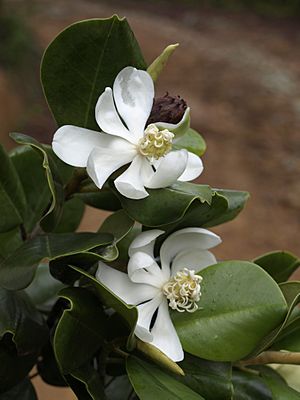Magnolia pallescens facts for kids
Quick facts for kids Magnolia pallescens |
|
|---|---|
 |
|
| Conservation status | |
| Scientific classification | |
| Genus: |
Magnolia
|
| Species: |
pallescens
|
| Synonyms | |
|
Dugandiodendron pallescens (Urb. & Ekman) Sima & S.G.Lu |
|
Magnolia pallescens is a special tree found only in the Dominican Republic. It is also known as the Ébano Verde, which means "Green Ebony." This beautiful tree is part of the large Magnolia family, famous for its lovely flowers. Sadly, the Ébano Verde is an endangered species. This means it is at a very high risk of disappearing forever.
Contents
About the Ébano Verde
The Ébano Verde is a type of Magnolia tree. Magnolias are ancient plants that have been around for millions of years. They are known for their large, often fragrant, flowers. The Ébano Verde is unique because it grows only in a specific part of the world.
Where the Ébano Verde Lives
This rare tree is found only in the Dominican Republic, a country in the Caribbean Sea. It grows in the mountain forests, especially in places like the Cordillera Central mountain range. These forests are often damp and misty, which is perfect for the Ébano Verde.
What the Ébano Verde Looks Like
The Ébano Verde is a medium to large tree. It can grow quite tall, reaching up to 20 meters (about 65 feet) in height. Its leaves are usually dark green and shiny. The tree gets its common name, "Green Ebony," from its very hard and dark wood. Its flowers are creamy white or yellowish. They have a lovely scent and are quite large. The fruits of the tree are cone-shaped and turn reddish when they are ripe.
Life Cycle and Reproduction
Like other flowering plants, the Ébano Verde reproduces using its flowers. The flowers contain both male and female parts. They are often pollinated by insects, such as beetles. After pollination, the flowers develop into fruits. These fruits contain seeds. When the seeds are ready, they fall to the ground. If conditions are right, a new Ébano Verde tree can grow from a seed. This process helps the species continue to exist.
Why the Ébano Verde is Endangered
The Ébano Verde is listed as an endangered species by the International Union for Conservation of Nature (IUCN). This means its population is very small and shrinking. There are several reasons why this tree is in danger:
- Habitat Loss: The biggest threat is the loss of its natural home. Forests where the Ébano Verde grows are being cut down. This happens for farming, building homes, or other human activities.
- Illegal Logging: The wood of the Ébano Verde is very valuable. It is strong and beautiful, similar to true ebony wood. Because of this, some people illegally cut down these trees. This further reduces their numbers.
- Small Population: Since there are already so few trees, it is harder for them to reproduce and recover. A small population is more vulnerable to diseases or natural disasters.
How We Can Help
Protecting the Ébano Verde is important for the environment. Here are some ways people are trying to help:
- Protected Areas: Some of the forests where the Ébano Verde grows are now protected. This means logging and other harmful activities are not allowed there.
- Reforestation: Efforts are being made to plant new Ébano Verde trees. This helps to restore the forests and increase the tree's population.
- Awareness: Teaching people about the importance of this tree helps. When more people know about the Ébano Verde, they can support conservation efforts.
By working together, we can help ensure that the beautiful Ébano Verde continues to thrive in the Dominican Republic for future generations.
See also
- In Spanish: Ébano verde para niños


